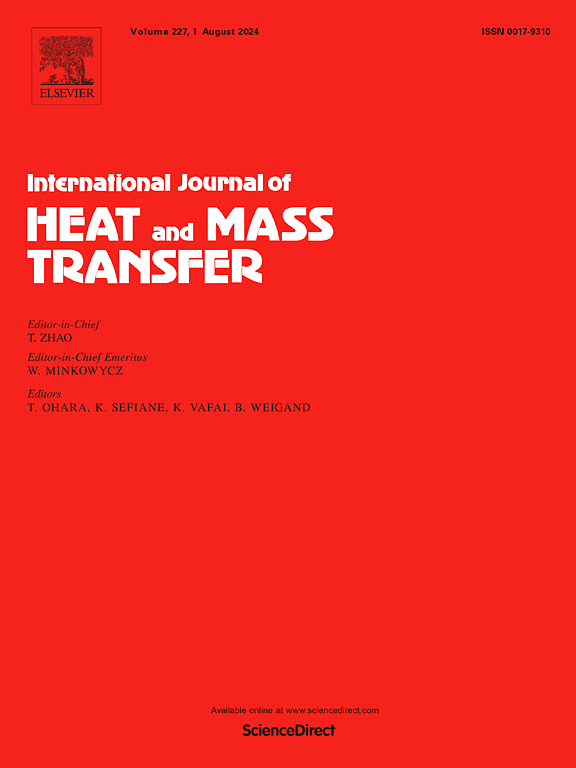利用新型爪形鳍片提高三管相变储能装置的能量存储/释放性能
IF 5
2区 工程技术
Q1 ENGINEERING, MECHANICAL
International Journal of Heat and Mass Transfer
Pub Date : 2024-11-01
DOI:10.1016/j.ijheatmasstransfer.2024.126368
引用次数: 0
摘要
为解决熔化和凝固过程中的传热差异,提高熔化/凝固循环的效率,开发了一种新型爪形鳍片。焓-多孔介质模型模拟了相变材料(PCM)的熔化和凝固过程。利用液体分数/温度等值线、液体分数曲线和努塞尔特数分析了支管数量、长度比 (L)、支管角度 (α)和鳍片材料对 PCM 相变过程的影响。结果表明,增加支管可改善熔化性能,这主要归因于增强了热传导,并通过改善径向温度响应来协调径向凝固速率。在翅片体积固定的情况下,增大 L 和减小 α 有利于缩短 PCM 的熔化和凝固时间。导热率较低的材料会削弱热量从鳍片基部快速传递到支部的能力,从而降低直接向 PCM 传热的效果。根据 RSM,L 比 α 对熔化/凝固性能的影响更大;与 V 形翅片相比,优化的四分支翅片(L = 1.7,α = 21.6°)可将熔化/凝固时间缩短 47.8%。进一步增加分支并不能明显提高传热性能。本文章由计算机程序翻译,如有差异,请以英文原文为准。
Enhancing the energy storage/release performance of a triple-tube phase change storage unit with novel claw-shaped fins
A novel claw-shaped fin has been developed to address the heat-transfer differences between the melting and solidification processes to enhance the efficiency of the melting/solidification cycles. The enthalpy-porous medium model simulated the phase change material's (PCM) melting and solidification process. The impact of branch number, length ratio (L), branch angle (α), and fin material on the PCM phase change process was analyzed utilizing liquid fraction/temperature contours, liquid fraction curves, and Nusselt numbers. Results indicate that the improvement in melting performance due to adding branches is primarily attributed to enhanced heat conduction and coordinates the radial solidification rate by improving the radial temperature response. For a fixed fin volume, increasing L and decreasing α are beneficial for reducing the PCM's melting and solidification times. Materials with lower thermal conductivity can weaken the ability of heat to transfer quickly from the fin base to the branches, thereby reducing the effectiveness of direct heat transfer to the PCM. Based on RSM, the L significantly impacts melting/solidification performance more than the α; the optimized four-branch fins (L = 1.7, α = 21.6°) reduce the melting/solidification time by 47.8 % compared to V-shaped fins. Further increasing branches does not significantly enhance heat-transfer performance.
求助全文
通过发布文献求助,成功后即可免费获取论文全文。
去求助
来源期刊
CiteScore
10.30
自引率
13.50%
发文量
1319
审稿时长
41 days
期刊介绍:
International Journal of Heat and Mass Transfer is the vehicle for the exchange of basic ideas in heat and mass transfer between research workers and engineers throughout the world. It focuses on both analytical and experimental research, with an emphasis on contributions which increase the basic understanding of transfer processes and their application to engineering problems.
Topics include:
-New methods of measuring and/or correlating transport-property data
-Energy engineering
-Environmental applications of heat and/or mass transfer

 求助内容:
求助内容: 应助结果提醒方式:
应助结果提醒方式:


